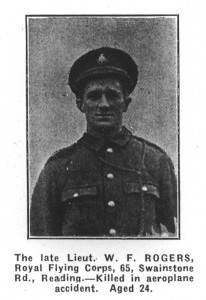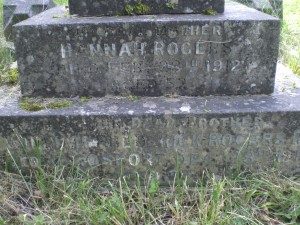The Slade family grave, number 11233; Berkshire Family History Society classification 44L26, commemorates the names of five ‘Dear friends, Killed in Action’. There were five Slade brothers serving in the army according to a cutting taken from the paper. In many newspaper reports the family address is given as Brunswick Street, Reading. It is known that the father also resided at 10, York Place, Reading.
 |
Alexander Alldridge DCM
CSM 9558 2nd South Lancashire Regiment
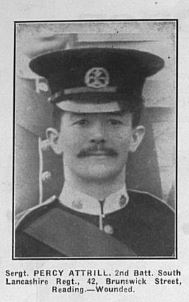 |
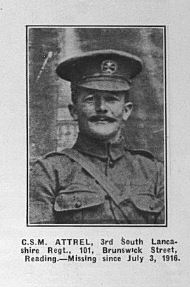 |
Alexander Alldridge, was the son of George Joseph and Edith Alldridge, of 9, Wood Street, Earlestown, Lancashire. He was killed on 13th July 1916 aged 23 and is buried at Bapaume Post Military Cemetery, Albert. Location I.E.14.
P. F. Attrill
Serjeant 8329
2nd Battalion, South Lancashire Regiment
Percy Attrill lived at 42, Brunswick Street and 101, Brunswick Street, Reading. He was aged 32 when he died on the 3rd July 1916. He is buried at Lonsdale Cemetery, Authuile, Somme. Location VI. V.3
Percy, who had married into the Slade family, had already served eleven years in the army when war broke out. The first reports about him in ‘The Standard’, appeared in February 1915. Percy had been wounded in the right arm during the Battle of Aisne, September 20th 1914. He was sent for treatment at No.5 Base hospital and spent one week in hospital in Cambridge. His injuries resulted in tetanus and for a time he had lock-jaw, there was also a worry that he would loose the use of three fingers on his right hand. However, he obviously recovered because he was posted as missing on July 3rd 1916. His wife, Edith, was seeking information about his whereabouts through out September 1916. Later the reports also included A.E. Slade .
Albert Edward Slade
Lance Corporal G/25352
16th Battalion Royal Fusiliers
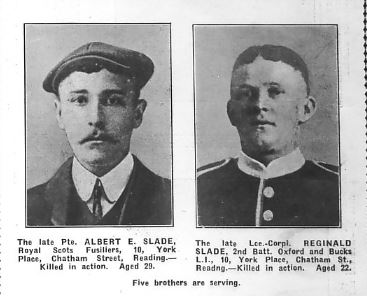 |
Albert E. Slade lived at 101, Brunswick Street, Reading. He died on the 23rd July 1916. He is buried at Delville Wood Cemetery, Longueval, Somme. Location XXII. H.5.
At the time of the 1911 census the family were recodedasliving at 60, Weldale Street. Albert was recorded as widower and a printers labourer,specifically a stone cleaner. His brother Ernest was recorded as an engine cleaner for the railways and brother Reginald worked in the tin factory making biscuit tins. Albert Slade was remembered by his father, brothers and sisters in ‘In Memoriam’, Reading Standard, 20th July 1918.
Two years have passed and still to memory dear,
We think of him and shed a silent tear
Friends may think the wound is healed
But sorrow beneath a smile if oft concealed.
S. Slade Lance Corporal
G/25352 16th Battalion Royal Fusiliers
S.Slade lived at Old Didcot. He died on the 19th April 1918. He is buried in the St. Sever Cemetery Extension, Rouen. Location P. XI. L. 10B.
Lance Corporal Slade died as a result of gas poisoning at No.3 Stationary Hospital France. He was the youngest of the Slade brothers.
J.F. Beechwood Private 207069 Royal Canadian Regiment
J.F.Beechwood died on the 9th April 1917. He is buried in La Chaudiere Military Cemetery, Vimy, Pas de Calais. Location VII.E.19
